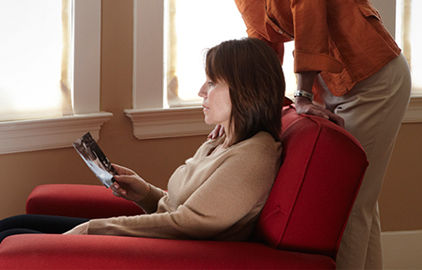Every person grieves differently. Just as no two lives are the same, so will each death, and each grief experience, be unique. Your experience may dramatically differ depending on how close you were to the person who has passed, for example, or the circumstances of their death—sudden or gradual. However, there is plenty of available information to help you come to terms with your individual grieving process and learn how to cope with your grief.
What are the stages of grief? What physical, mental, and emotional symptoms can you expect as you grieve? What are common myths about grief? What coping strategies can help you grieve in a healthy way? This SevenPonds section will answer all of these important questions about the grieving process.
Things to Know:
- Everyone grieves differently: what you should expect is a variety of intense emotions, as well as physical symptoms, which can come about in any order. It’s important to understand that what you are experiencing is normal.
- It is always better to talk about your grief and deal with it directly than to ignore or suppress it.
- A support system that assists you with your emotional and practical needs can help ease the grieving process.
- Many people find comfort in ritual, such as memorial services or end-of-life celebrations, which can be healthy outlets to come together and openly mourn with others.
What are the stages of grief?
Most people have heard of the five stages of grief, also known as the Kubler-Ross model. Elisabeth Kubler-Ross was a groundbreaking psychiatrist who ignited public conversation about death in a time when the subject was largely taboo. Her 1969 book, On Death and Dying, introduced the world to the five stages of grief: denial, anger, bargaining, depression, and acceptance. Though the stages were originally intended to reflect the experiences of those dying, Kubler-Ross later extended their definition to encompass the experiences of anyone who has suffered a loss or tragedy. The five stages are:
- Denial: This stage is often experienced as a state of shock. You may feel numb, disoriented, or overwhelmed. Some report a trance-like state or a sense of unreality. Though confusing, these feelings help us to slowly come to terms with the reality of the loss, rather than dealing with all of our emotions up front.
- Anger: Anger can be directed at anyone who you feel has blame in your loss. You might feel anger toward your family and friends, your loved one who has passed, or the doctors who were unable to save them. You may also be angry with yourself or the world. This anger is a manifestation of the pain of your loss; it can be understood as a measure of your love for the person.
- Bargaining: You may find yourself asking “what if” questions, thinking about what could have been done to save your loved one, and perhaps bargaining with God or the world: “If I could have just one more day with them…” Bargaining is often accompanied by guilt. This is basically our way of negotiating with the hurt and pain of the loss.
- Depression: Depression and sadness are the most recognizable, commonly-accepted symptoms of grief, yet all too often grieving persons are expected to “snap out of it” and act normal. It’s important to understand that after the loss of a loved one, depression is a perfectly normal emotional response. During this stage, you will likely withdraw from normal activities and feel as if you are in a fog of sadness. You may find it difficult to go on without that person in your life.
- Acceptance: This is the point where we accept our new reality, one in which our loved one is no longer present. Acceptance does not necessarily mean that you’re “okay” with your situation; it simply means you recognize that the person is indeed gone, that your situation has changed. Acceptance is also when we begin to pick up the pieces and reorganize our lives to fit in with this new reality.
The five stages of grief are not linear; they can occur in any order, and possibly more than once. While the Kubler-Ross model is the most widely recognized, there are many variations, typically ranging from three to seven stages. They may have slightly different titles—“guilt” instead of “bargaining,” for example. When researching these, it’s easy to feel inundated with information regarding exactly what “stages” you will experience. Keep in mind that these are broad guidelines to help you understand your grief, not to-the-letter definitions. The goal of these models is to help you accept that though your feelings and reactions can be scary or overwhelming, they are a normal part of grieving, and allowing yourself to experience them will ultimately aid you in healing.
There have also been some new schools of thought that contest the traditional Kubler-Ross model of five stages of grief. One of these is found in Ruth Davis Konigsberg’s 2011 book The Truth about Grief. Konigsberg believes this model privileges negative over positive emotions; instead, she seeks to downplay the importance of mourning and emphasize the power of human resilience. Konigsberg’s book is based on recent studies which show that those who’ve experienced a loss actually “accept” the death of their loved one quite early, and are more likely to experience yearning and longing for the loved one than anger or depression. It should be noted that this is a fairly new theory, and the majority of grief resources continue to subscribe to a model similar, if not identical, to Elisabeth Kubler-Ross’s.
What are the physical, mental, and emotional symptoms of grief?
Grief can impact all spheres of a person’s life. Some will feel angry and reject previously held beliefs, while others may find comfort in their faith or spirituality. You may experience grief not just for the person, but also for your expectations in your relationship with them that were never met.
While symptoms vary widely from person to person, there are several physical, mental, and emotional symptoms that are commonly experienced in the grief process.
Physical symptoms include:
- Headaches and body aches
- Tightness in chest
- Fatigue or exhaustion
- Sensitive skin
- Dizziness
- Shortness of breath
- Increased illness
- Oversensitivity to noise
- Heart palpitations
- Loss of appetite or weight gain
Mental symptoms include:
- Forgetfulness
- Sleep difficulties (too much or too little)
- Inability to concentrate
- Confusion
- Decreased decision-making or problem-solving abilities
- Low self-image
- Self-destructive thoughts
Emotional symptoms include:
- Depression
- Anger
- Helplessness
- Anxiety
- Mood swings
- Hysteria
What are the common myths of grief?
One common misconception is that grief progresses in a linear fashion and slowly and steadily gets better with time. In reality, grieving tends to be a day-by-day process, and some days will be easier than others. There is no clear duration that grieving is supposed to last; “stages” can come and go and everyone will experience them differently.
Another misconception is the idea that if someone is not outwardly displaying their grief, they are “doing well” and “staying strong.” This is a misplaced value that tends to be encouraged in our society, as many people are uncomfortable with displays of raw emotion and designate them as a sign of weakness. Holding your grief inside can actually repress your thoughts and feelings in an unhealthy way. Often, such repression can lead to your grief resurfacing at an unexpected point later in life. Allowing yourself to feel, to sort through your emotions, and to mourn outwardly are very important steps in the healing process, which is why it is important that you have someone — a family member, a trusted friend, or a support group — that you can talk to.
What coping strategies can help you deal with grief?
There are many things you can do to help mitigate the overwhelming feelings that accompany a major loss. One key component of dealing with grief in a healthy way is to simply let it happen. Allow yourself to feel each emotion as it arises. Take some time each day to truly accept the loss of the loved one and to reflect on your relationship with them. Experiencing pain, anger, depression, even numbness is completely normal; trying to push down or brush off these emotions is unhealthy and can delay the healing process.
Grief can often make it difficult to function as well as we are used to in day-to-day life. It’s a good idea to lighten your schedule as much as possible in the days, weeks, and months following a loss. Make sure you are taking good care of yourself, mind, spirit, and body. Some people find creative projects and hobbies to be therapeutic outlets. Many also take comfort in ritual: a memorial service or end-of-life celebration can be a healthy way to outwardly express your grief and give you and your loved ones a sense of closure.
It is also very important to make sure you have a support system, as no one should be expected to grieve alone. Reach out to friends and family; don’t wait for them to come to you. Talk to people about your feelings, and ask them for practical assistance if you need it: cleaning the house, looking after the kids, preparing meals, etc. You may also find comfort in attending support groups and grief meetings, where you can express your grief openly to others who have experienced loss. While most support groups provide emotional counseling, newer approaches like Lyn Prashant’s “Degriefing” program offer both physical and emotional therapy. Research services in your area and find one that works for you.
For Further Information:
“The Journey through Grief: The Mourner’s Six Reconciliation Needs”
Kara, by Alan D. Wolfelt, Ph.D.
http://www.kara-grief.org/HelpDocs/ReconciliationNeeds.htm
Recover from Grief Loss: Creative Healing Techniques
http://www.recover-from-grief.com/
The Five Stages of Grief
http://grief.com/the-five-stages-of-grief/
“How We Die Now: Five New Stages, Family Included”
An Interview with Barbara Okun, Co-Author of Saying Goodbye
http://commonhealth.wbur.org/2011/08/five-stages-dying/







